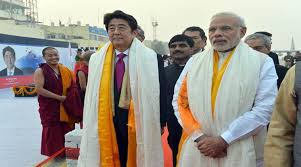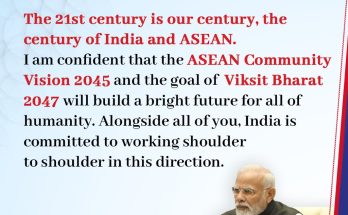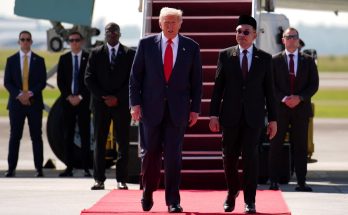
Driven by a matrix of conjoined strategic and economic interests in the shifting Asian geopolitical landscape, India’s global and strategic partnership is poised to scale new frontiers by 2020, says Aftab Seth
India and Japan have enjoyed a relationship spanning 15 centuries, which has been underpinned by a strong civilizational foundation. The gentle message of Lord Buddha was spread throughout the country by Prince Regent Shoutoku, who used the prestige of the Imperial Court to propagate the ideals, which had emanated from India and which had influenced the whole of Asia from Burma to Japan. Temples and shrines that dot the magnificent Japanese archipelago have images of gods and goddesses like Saraswati and Ganesh and other names familiar to the Indian sub-continent.
Cultural Affinity
In the late 19th and early 20th centuries these ancient links were reinforced by great spiritual leaders such as Rabindranath Tagore and Swami Vivekananda who travelled to Japan and renewed the message of peace and universal brotherhood that had first come to Japanese shores many centuries earlier.
At the political level, the rapid rise of Japan after the Meiji Restoration of 1868 and its transformation into an industrial country, with a powerful army and navy, impressed many political leaders in India who were struggling against British colonialism. The defeat of the powerful Chinese Empire in 1895 and of Russia, the largest European empire in 1905, at the hands of the Japanese, had a profound effect on national movements in India, Burma, Vietnam and Indonesia. The Indian National Congress split between activists who espoused emulation of Japan and those who preferred more constitutional methods of struggle. Similar struggles at the ideological level emerged under Phan Boi Chau in Vietnam, Sukarno in Indonesia and Aung San in Burma; all these leaders favoured following the Japanese example of using military force.
In India, Rash Behari Bose in the 1920s and Subhash Chandra Bose in the 1940s were national leaders who made a clear choice in favour of Japan.
The dissenting judgement of Indian Judge Radha Benod Pal, who served on the Tokyo War Crimes Tribunal set up by the victors of the Second World War, held the Japanese wartime leaders as being “Not Guilty.” This had an electrifying effect on the Japanese people, when the judgment was publicised after the end of the American occupation and the lifting of censorship. This positive fact and Nehru’s admiration for Japan and its culture, though not its militarism, led to the loosening up of iron ore exports from India to Japan with a view to assisting in the rehabilitation of the steel industry destroyed by the war.
The upshot of these gestures of friendship was that when the economy of Japan recovered in the 1950s, India became the first country to receive ODA from Japan in 1958.
The economic cooperation between India and Japan in the 20th century dates from that time and included a modest trade. However as a consequence of the Cold War and Japan’s security alliance with the USA and India’s perceived closeness to the Soviet Union and its planned economy, the relationship remained at a relatively low level.
The Turning Point: May 1998
If one was to choose a watershed in the start of a strategic relationship, it was ironically the nuclear tests of May 1998 under then Prime Minister Atal Behari Vajpayee. Though initially it led to a set of strict sanctions against India, within the space of two to three years the misunderstandings began to evaporate and the beginnings of cooperation between the defence and foreign ministries at one level and between the armies, navies and coast guards at another level became increasingly frequent and intense. After the July 2005 defence and civil nuclear agreement between the US and India under George W. Bush and Manmohan Singh, the diplomatic and in a sense the legal framework for trilateral cooperation between the US, Japan and India was laid. From 2007 onwards, the trilateral naval cooperation and strategic dialogues began to be held. In January 2014 Shinzo Abe became the first Japanese Prime Minister to be India’s guest of honour at the Republic Day parade, where the full might of the Indian armed forces is put on display. His presence at this event was highly symbolic of the great distance the two countries covered in a relatively short space of 15 years.
With the advent of Prime Minister Narendra Modi to power, the “Global and Strategic Partnership” announced in December 2006 by Manmohan Singh and Abe was raised to the level of “SPECIAL” Global and Strategic Partnership on September 1, 2014, during Modi’s visit to Japan at the invitation of PM Abe. Significantly, this was PM Modi’s first visit outside the SAARC region after taking over in May 2014, signalling the increased focus on Japan in his foreign policy calculus.
Nuclear Rapprochement: Leap of Faith
In December 2015 negotiations that had been going on from 2010 on nuclear cooperation for civilian purposes reached a major point of decision during PM Abe’s visit to India.
On November 11, 2016, this process was carried forward to its conclusion during PM Modi’s visit to Japan. As a leading commentator P. S. Suryanarayana at the Institute of South Asian Studies in Singapore put it, this agreement on nuclear cooperation was for Tokyo “a leap of faith into the metaphoric outer space of international diplomacy.” This was so because Japan has been very wary of conducting nuclear cooperation with any country that has not signed the NPT, being the only country to have suffered a nuclear attack in 1945. Thus, agreements with countries like Vietnam had been signed several years ago but with India Japan had hesitated until now. This exception that has been made for India is highly symbolic of the sense of trust that Japan has for India’s impeccable record of not exporting its nuclear technologies, irrespective of the fact that India has not been a signatory to either NPT or CTBT. The two PMs declared that the agreement serves the cause of a “peaceful and secure world.” The agreement still has to secure the approval of the Diet. If that goes through, it will open the way over the next five years for Toshiba, Hitachi, Mitsubishi and their US collaborators like General Electric and Westinghouse to export huge quantities of equipment for building nuclear power plants in India.
Maritime Cooperation
The next few years will also see an enhancement in maritime cooperation between the two countries. The historic visit of PM Mori to India in August 2000 marks the start of the strategic relationship, including in the maritime dimension. The November 2016 joint statement highlights the increasing salience of maritime relationship in the burgeoning India-Japan relations. In fact just before the December 2015 summit in Delhi, the navies of Japan, India and the US had participated in the trilateral Malabar naval exercises in the Indian Ocean. These have now become an annual feature. India’s interest in this equation is obvious as it seeks to preserve its status and role as the dominant actor in the Indian Ocean. Japan encourages this role by India not only in the Indian Ocean but beyond in the larger Indo-Pacific region. PM Abe’s speech on the “Confluence of the Two Seas,” made in India’s Parliament in August 2007, makes this aspect of Japan’s policy clear. The need to balance China and its Maritime Silk Road project drives the thinking of strategists in both countries. Chinese submarines frequently docking at Sri Lankan ports, the development of Gwadar port in Pakistan and Chinese projects in the Maldives, Myanmar and Mauritius underline the need for strengthened maritime cooperation between India and Japan. Japan’s offer to develop the strategic Andaman and Nicobar Islands may be seen in this context; as also the plan for joint development projects in Iran and Afghanistan, specifically the Chabahar port in Iran. These are significant landmarks in the evolving India-Japan security relationship
Economic Cooperation
Since 2003, India has been the largest recipient of ODA in Asia. It was in that year that Japan linked its ODA for the first time to an effort to “maintain and strengthen international peace and stability.” This new strategic dimension of its ODA policy has enabled Japan to supply Coast Guard vessels to Indonesia and has much significance for the cooperation with India. Thus there is an emphasis on improving India’s infrastructure and its connectivity both within the country and with the neighbouring region of Southeast Asia. The interlinked One Belt One Road and the Maritime Silk Road projects of China are of strategic concern to both Japan and India. The Japanese decision to help build the Mumbai-Ahmedabad shinkansen and many projects for underground systems in Chennai, Bangalore and other cities, are concrete evidence of Japan’s determination to help strengthen the infrastructure of India. The Mumbai-Ahmedabad link will cost up to $15 billion of which Abe already had pledged a loan of $ 12 billion, at highly favourable terms for India, in December 2015. Delhi Metro, which Japan helped build, was completed almost three years ahead of schedule. This is ample demonstration of the speed, reliability and high quality of Japanese economic cooperation.
The Road Ahead
Japanese Partnership for Quality Infrastructure in India’s North-eastern states and in the Andaman and Nicobar Islands may also be seen in the overall strategic context. These islands are used by the Indian Navy and hence are useful for keeping a watch on the activities of the Chinese in the region.
Looking ahead, both Abe and Modi underscored the importance of working together in Africa. It is well known that China has made many efforts to expand its economic influence in Africa even in countries where there are significant numbers of people of Indian origin. Both countries could also work together in countries like Bangladesh, where Japan is trying to invest in the Bay of Bengal Industrial Growth Belt. The Matarbari Island is one such project where both countries could collaborate.
It is evident that India and Japan have widened and deepened the bilateral relationship to a degree which would have been unimaginable 15 years ago.
As vibrant practising democracies, which believe in open societies and pluralism, India and Japan are poised to become even closer than they are today. PM Abe once said that he sees a time when the India- Japan partnership may overtake the traditional 65-year partnership between Japan and the USA! Those who believe in this unique bilateral relationship hope that Abe’s prediction will become a reality in the years ahead.
(Aftab Seth is a former ambassador of India to Japan. This article was published in India and World, a quarterly magazine on international affairs, published by India Writes Network/TGII Media Private Limited. To subscribe to India and World, write to ed****@*********es.org)
Author Profile
- India Writes Network (www.indiawrites.org) is an emerging think tank and a media-publishing company focused on international affairs & the India Story. Centre for Global India Insights is the research arm of India Writes Network. To subscribe to India and the World, write to editor@indiawrites.org. A venture of TGII Media Private Limited, a leading media, publishing and consultancy company, IWN has carved a niche for balanced and exhaustive reporting and analysis of international affairs. Eminent personalities, politicians, diplomats, authors, strategy gurus and news-makers have contributed to India Writes Network, as also “India and the World,” a magazine focused on global affairs.
Latest entries
 DiplomacyOctober 4, 2025UNGA Resolution 2758 Must Not Be Distorted, One-China Principle Brooks No Challenge
DiplomacyOctober 4, 2025UNGA Resolution 2758 Must Not Be Distorted, One-China Principle Brooks No Challenge India and the WorldJuly 26, 2025MPs, diplomats laud Operation Sindoor, call for national unity to combat Pakistan-sponsored terror
India and the WorldJuly 26, 2025MPs, diplomats laud Operation Sindoor, call for national unity to combat Pakistan-sponsored terror India and the WorldJuly 25, 2025When Fire Ends, Diplomacy Begins
India and the WorldJuly 25, 2025When Fire Ends, Diplomacy Begins India and the WorldJuly 16, 2025Operation Sindoor and its Aftermath: India’s Successful Diplomatic Outreach
India and the WorldJuly 16, 2025Operation Sindoor and its Aftermath: India’s Successful Diplomatic Outreach







